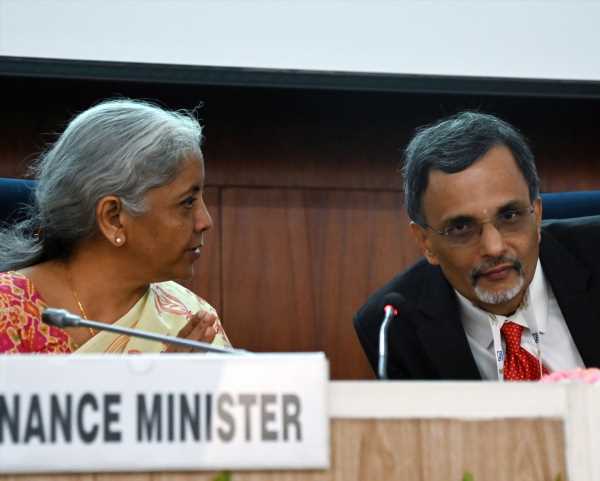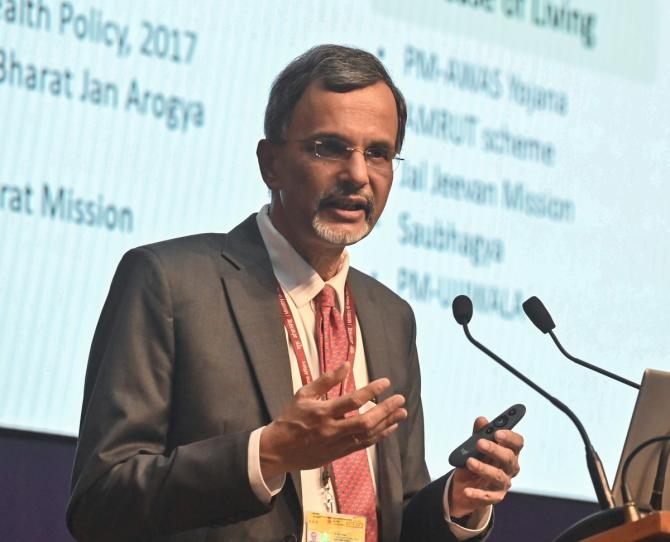‘… and without necessarily calling them Economic Surveys.’
‘One should stick to the main focus, which is to give people a good perspective on how the economy is doing.’
The private sector has restored its profitability and balance-sheet strength, and thus should increase its capital expenditure plans, says Chief Economic Advisor V Anantha Nageswaran.
In an exclusive interaction with Arup Roychoudhury and Asit Ranjan Mishra/Business Standard, Nageswaran says Budget-deficit targets should be decided solely by debt levels and the government’s ability to spend money effectively.
You have said a moderate to significant global economic slowdown will work in favour of India. Are you indicating that the Indian economy has decoupled from the developed world?
We have not decoupled. I would argue we are coupled in different ways.
One is to always think strong growth means better export prospects. But when we face imports of important items and when strong growth in the developed world has implications for interest rates, the strength of the currency, demand for commodities, oil prices, etc, you must consider all these factors.
That’s why I said ‘on balance’, on a net basis, a global economy that is slowing is on balance a better thing for India in the current context.
You have supported capex-led growth. So, do you think for a few more years the Centre needs to continue to push capex to support growth or do you see the private sector taking that position in the coming years?
That too is a function of the economic cycle because in the last several years the private sector was reluctant to borrow and invest because it was nursing its balance sheet and banks had become cautious.
They were more willing to lend to extremely creditworthy borrowers and the state was the most important creditworthy of them.
When we let many public-sector enterprises borrow on their own account and undertake capital expenditure, some people thought internal and external budgetary resources were understating overall government expenditure.
So we reduced off-Budget borrowing and the government’s public investment went up, both as a matter of strategy as a policy conscious policy choice. And it also took into consideration the circumstances prevailing in the financial system at that point.
But now, if the private sector has restored its profitability and balance-sheet strength, and there is demand and there is demand visibility, it should come back and start to invest, in which case the government should be in a position to retreat and direct its expenditure to other development causes. So this is a matter of judgement.
You said the government was on track to achieve a 6.4 per cent fiscal-deficit target in FY23. And that means the medium-term road map of 4.5 per cent by FY26 is being adhered to. But what sort of deficit should we be targeting beyond FY26?
That’s a good question and it’ll be somewhat presumptuous on my part to try and answer it right away without thinking it through, because what a sustainable level of deficit is, and what is the deficit level that crowds out the private sector and becomes economically unproductive — all these things we need to think through before coming up with a one-point estimate in this matter.
At the end of the day, if your debt levels are sustainable, and if the government is in a position to spend money effectively, and in areas where it needs to be spending, those kinds of considerations will determine what the deficit number should be.
We need to assess various factors and take economic cycles into consideration before we are able to come up with a one-point estimate for this.
Don’t you think rising interest rates may impact domestic consumption and credit growth in FY24?
If you look at the real policy rate, it’s not very high.
In the mid-1990s, real interest rates were quite high in the United States — at around 3 per cent. But that did not stop credit growth or economic or capital formation in the US economy because the high real interest rate reflected potential GDP growth in the economy.
Traditionally under this government, Economic Surveys have been presented in two volumes except last year. Do you think a single-volume Economic Survey makes more sense?
Yes, I guess it makes sense because the idea is to present an assessment of the economy and not so much one’s own thoughts.
One should stick to the main focus, which is to give people a good perspective on how the economy is doing.
If at all we want to fly some kites, we can fly them in different ways and without necessarily calling them Economic Surveys.
We believe you may come up with a further update on the Indian economy a few months down the line?
Yes, we will do that because normally Economic Surveys are produced with eight to nine months of data. So we will provide an update.
By when can we expect the update?
I have to discuss it internally because we have to take into consideration the G-20 calendar as well and it may be a good idea to present this after the calendar is over.
You have said public-sector asset monetisation can lead to an upgrade in sovereign credit ratings by lowering public-sector debt. Do you think a high debt-to-GDP ratio is the only factor hindering a rating upgrade for India?
That is what most of them (rating agencies) refer to in their assessments.
They say for the peer group of BBB minus, your debt-to-GDP ratio is high.
Although our debt is largely domestically held and denominated in the domestic currency, that doesn’t figure and the fact that we have debt sustainability in terms of higher nominal GDP growth relative to cost of capital.
More than that they look at the debt stock and that is why I said sometimes we could reduce the asset side of the balance sheet and use the proceeds to reduce the liabilities side.
Then the debt stock comes down, the debt-to-GDP ratio reduces and your interest component of revenue expenditure comes down. So a lot of good things happen.
Feature Presentation: Rajesh Alva/Rediff.com
Source: Read Full Article




